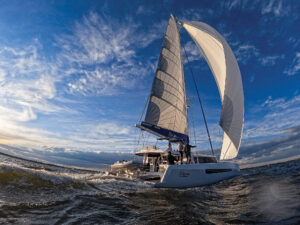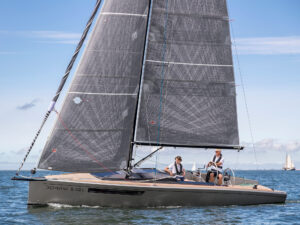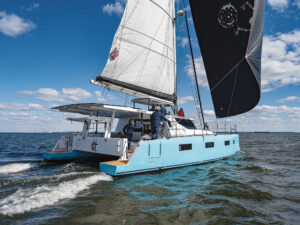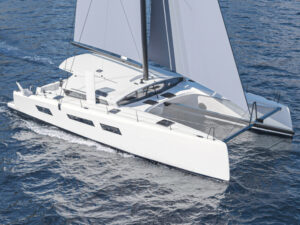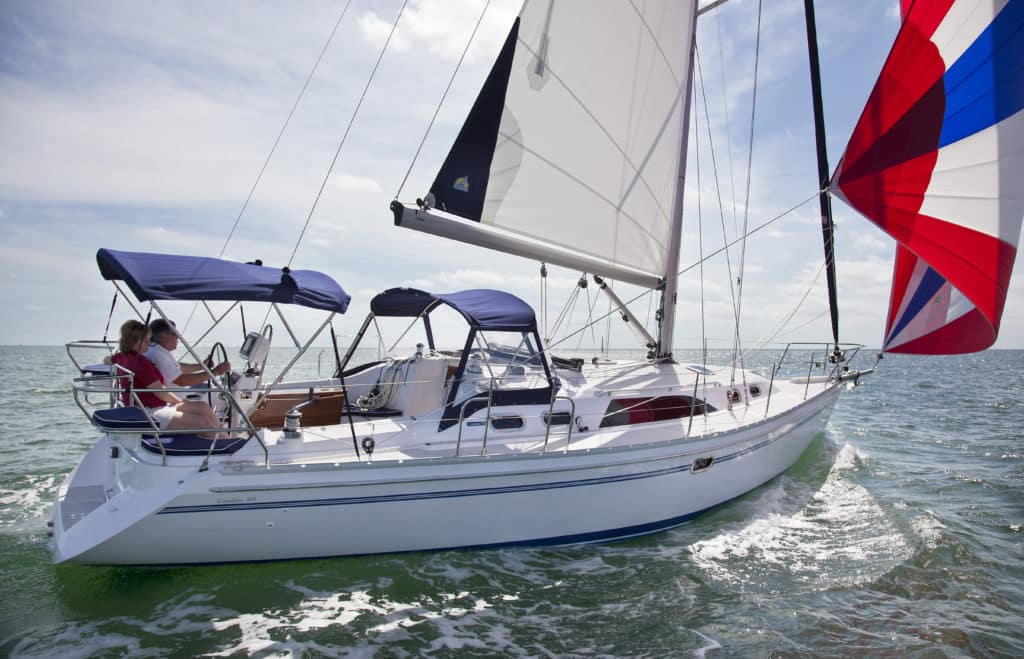
Incessant market demand for ever-more-spacious interiors has led to incremental yet ultimately substantial increases in the average freeboard, beam-to-length ratio, and transom width of modern sailboats. Unchecked, this volume-driven trend will undoubtedly exceed limitations affecting sensible deck layout, sailing performance, seakindliness, and aesthetics.
With the Catalina 385, a midsize family cruiser, Catalina Yachts’ Gerry Douglas is purposely bucking that tide by returning to what he believes are more balanced proportions and traditional styling.
I suspect that the market will reward this return to reason, for the 385 presents the appealing look of a “modern classic,” and from this there are numerous practical effects to be had. For example, the lowered freeboard allows the on-deck workstations to be brought closer to the center of gravity, thus reducing motion and enhancing safety.
The moderate beam translates into better tracking and less of a penchant for the boat to round up when pushed onto a heavy heel. Some initial form stability may be lost with the reduced beam, but the overall righting forces are dramatically increased in the event of knockdown or capsize.
Not having to contort the deck to conform to excessive spatial requirements below freed Douglas to draw a simple yet spacious T-shaped cockpit. Long, wide, and high-backed benches run from the companionway aft to the steering pedestal. The T then allows the helmsman to sit and steer from either side of the boat or from the removable central helm seat. Despite the wheel’s large diameter, the 7 inches of clearance between the helm and the cockpit sidewalls permits safe and unimpeded access to the winches and running rigging on the cabin top. Once at anchor, the wheel collapses onto itself, eliminating the necessity of removing it for social occasions. Comfortable viewing seats are molded into the robust stern pulpit, adding to the usable outdoor spaces.
The cockpit self-bails through the aft entry, and a 9-inch bridgedeck protects against downflooding. Attractive teak grates keep the feet dry. The wooden cockpit table is strong, practical, and particularly beautiful.
Lifelines that stand 27 inches tall, aggressive nonskid, and good handholds create a safe flow forward. The deep anchor-rode locker houses a powerful electric windlass with both chain and rope gypsies and a stout chain stop. A sizable cleat is provided to make fast snubbers or rope rodes. The up/down switches are convenient yet safely recessed. The twin anchor rollers stand proud enough to protect the stem from damage.
A welcome foredeck feature is a removable strut from which to fly an asymmetric spinnaker, increasingly the downwind sail of choice.
With a SA/D ratio of 17.4, narrower lines, and sophisticated appendages (the lead keel comes in a 4-foot-8-inch bulb or a 6-foot-10-inch fin configuration), the 385 should prove lively in a wide range of winds. Unfortunately, on the day of our test sail, we had nothing but the lightest of zephyrs. But through aggressive maneuvers under power, I was able to get a feel for a hull that should be slippery, quick, and stand up well to its generous canvas.
A long traveler with a 6:1 adjuster will provide precise mainsheet control. The helm and engine controls were very smooth, and the Yanmar 40-horsepower diesel produced good power and pace. Catalina still uses traditional shaft drives. While simple to inspect and maintain, they do produce more decibels below.
I’d recommend that potential buyers first discuss in detail what canvas arrangements they prefer, because on the boat we sailed, the bimini, as fitted, totally obstructed any safe view of the mainsail.
The hull is solid glass and vinylester from a foot above the waterline down, and balsa cored from there up. The 4-inch-wide internal hull/deck flange is well bonded and fastened on 2-inch centers. A substantial structural grid absorbs the rigging loads, while a separate liner accepts the interior furniture. Although more likely used as a weekend or coastal cruiser, the 385’s European Union Category A rating, crash-box bulkhead, and ample tank sizes makes this, with a few modifications, a viable offshore candidate.
_View more photos of the Catalina 385 here._
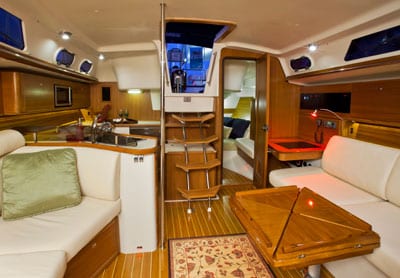
The hand-finished teak interior comes in a two-cabin layout with a large V-berth forward and an athwart double aft. By designing in only one head with shower, Douglas has recaptured the interior volume lost to on-deck considerations. To my mind, it’s a winning trade-off.
The forepeak berth has a clever lifting bed-head that allows one to relax and read comfortably in bed. The stowage is large and easily accessed.
The saloon has an L-shaped settee surrounding an attractive four-leaf expanding table. The end of the port settee acts as the nav-station seat. Across to starboard, twin captain’s chairs sit fore and aft of a cocktail table that drops into a sea berth.
The galley is safely enclosed for cooking under way. It includes a two-burner stove, a microwave, a refrigerator, a large sliding trash bin, two deep sinks, and an opaque splashboard that separates the galley, but not the cook, from the main saloon.
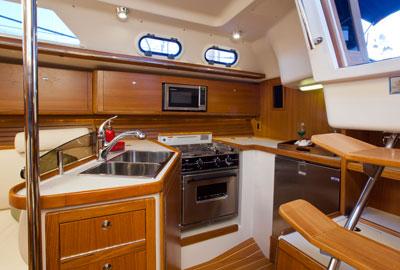
Catalina gets so many small things right—the little makeup table in the forepeak, a large bank of drawers, a huge hanging locker, lifting pistons on locker lids, to name but a few.
Engine access under the companionway ladder is excellent. The bilges are well laid out, and absolutely everything is labeled. While we found a couple of nicks to grumble about in this boat, which is hull number one, I believe that Catalina’s usual attention to detail, up front and backstage, will be found on subsequent hulls.
Gerry Douglas has tacked off from the main fleet, so to speak, in two other directions. First, he says he wanted to “de-content” the boat—that is, not crowd it with a boatload of modern accoutrements and gadgetry. Secondly, he’s purposely allowed some financial daylight to appear between Catalina and lower-priced models in this class. He believes that this upward repositioning in quality and cost will help keep Catalina commercially viable in today’s market.
In short, the 385 should appeal to sailors who plan to spend a good deal of their time off the dock and actually out there, where these modest changes toward traditional lines will pay more than modest dividends.
View more photos of the Catalina 385 here.
Specs
LOA 39′ 2″ (11.94 m.)
LWL 35′ 5″ (10.80 m.)
Beam 13′ 1″ (3.99 m.)
Shoal Draft 4′ 8″ (1.42 m.)
Fin Draft 6′ 10″ (2.08 m.)
Sail Area (100%) 675 sq. ft. (62.7 sq. m.)
Ballast (shoal) 6,200 lb. (2,812 kg.)
Ballast (fin) 5,200 lb. (2,359 kg.)
Displacement 15,500 lb. (7,031 kg.)
Ballast/D (shoal) .40
Ballast/D (fin) .34
D/L 156
SA/D 17.4
Water 100 gal. (379 l.)
Fuel 40 gal. (151 l.)
Holding 30 gal. (113 l.)
Mast Height 54′ 0″ (16.46 m.)
Engine 40-hp. Yanmar
Designer Gerry Douglas
Price $208,495 (base)
Catalina Yachts
(727) 544-6681
www.catalinayachts.com
Alvah Simon, a CW_ contributing editor, is a veteran Boat of the Year judge._

